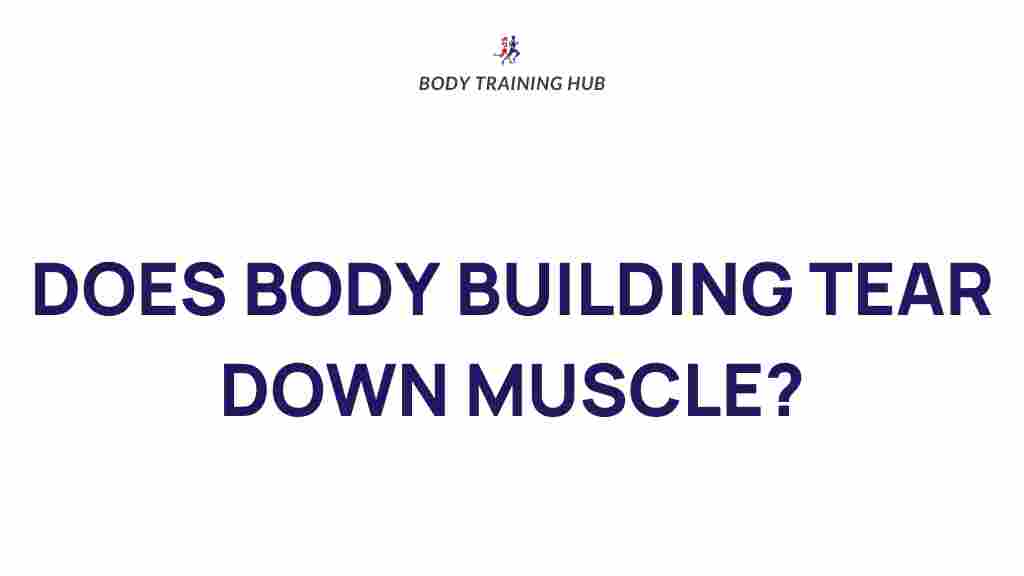Unraveling the Mystery of Muscle Breakdown in Bodybuilding
Bodybuilding is an intricate dance of science and art, where understanding the mechanics of muscle breakdown is crucial for anyone seeking to enhance their physique. As a bodybuilder, you constantly strive for muscle growth through rigorous strength training, but what happens to your muscles during and after these intense workouts? This article delves into the phenomenon of muscle breakdown, its implications for muscle recovery, and how to effectively navigate the path to optimal muscle health.
Understanding Muscle Breakdown
Muscle breakdown, often referred to as muscle catabolism, is a natural process that occurs during intense physical activity. Understanding this process is vital for bodybuilders who want to maximize their gains while minimizing potential setbacks.
When you engage in strength training, your muscles experience micro-tears. This is a normal part of the muscle-building process, but it can also lead to muscle breakdown if not managed properly. Here’s how it works:
- Micro-Tears: During workouts, particularly with heavy weights, small tears occur in the muscle fibers.
- Body’s Response: The body responds to these micro-tears by initiating the muscle repair process, which involves both muscle recovery and muscle growth.
- Energy Depletion: Intense workouts lead to the depletion of glycogen stores, causing the body to break down muscle tissue for energy.
The Role of Muscle Breakdown in Muscle Growth
Muscle breakdown is not inherently bad; in fact, it plays a critical role in muscle growth. Here’s how:
- Stimulating Growth: The process of muscle breakdown triggers the body to rebuild stronger and larger muscle fibers.
- Hormonal Response: Exercise-induced muscle breakdown stimulates the release of hormones like testosterone and growth hormone, which are crucial for muscle recovery and growth.
The Balance Between Breakdown and Recovery
Achieving a balance between muscle breakdown and recovery is essential for maximizing muscle growth. Overtraining can lead to excessive muscle breakdown, hindering your progress and increasing the risk of injury. Here are some strategies to maintain this balance:
- Listen to Your Body: Pay attention to signs of fatigue and soreness. Adequate rest is vital.
- Nutrition: Ensure you consume enough protein and calories to support muscle repair and growth.
- Hydration: Staying hydrated aids in recovery and helps prevent muscle cramps.
The Process of Muscle Recovery
Effective muscle recovery is a multi-faceted approach that includes proper nutrition, rest, and active recovery strategies.
Step-by-Step Muscle Recovery Process
Here’s a structured approach to enhancing your muscle recovery:
- Post-Workout Nutrition: Within 30 minutes of your workout, consume a meal rich in protein and carbohydrates. This helps replenish glycogen stores and provides the building blocks for muscle repair.
- Rest and Sleep: Aim for at least 7-9 hours of sleep per night. Sleep is when your body goes into repair mode, releasing growth hormones that aid in muscle growth.
- Active Recovery: Engage in light activities like walking, cycling, or yoga on rest days to promote blood flow and reduce muscle soreness.
- Stretching and Foam Rolling: Incorporate stretching and foam rolling into your routine to improve flexibility and alleviate muscle tightness.
- Supplementation: Consider supplements like branched-chain amino acids (BCAAs) and glutamine to support recovery.
Nutrition for Muscle Recovery
Your diet is a cornerstone of effective muscle recovery. Here are some key nutrients to focus on:
- Protein: Essential for muscle repair. Aim for 1.6 to 2.2 grams of protein per kilogram of body weight.
- Carbohydrates: Replenish glycogen stores. Include complex carbs like oats, brown rice, and sweet potatoes.
- Healthy Fats: Support hormone production. Include sources like avocados, nuts, and olive oil.
Troubleshooting Muscle Breakdown and Recovery Issues
Even with the best intentions, you may encounter challenges in managing muscle breakdown and recovery. Here are some common issues and solutions:
Signs of Overtraining
Overtraining can lead to excessive muscle breakdown and hinder progress. Watch for these signs:
- Persistent fatigue
- Decreased performance
- Increased susceptibility to illness
- Sleep disturbances
- Chronic muscle soreness
If you notice these symptoms, consider scaling back your training intensity and volume. Incorporate more rest days and focus on recovery strategies.
Nutrition Shortfalls
A lack of proper nutrition can severely impact your recovery. If you’re not seeing the desired results, evaluate your diet:
- Are you getting enough protein?
- Are you consuming enough calories to support your activity level?
- Are you hydrating adequately?
Adjust your diet as needed to ensure you’re meeting your nutritional requirements.
Stress Management
Chronic stress can interfere with muscle recovery and growth. Incorporate stress management techniques such as:
- Meditation and mindfulness practices
- Deep breathing exercises
- Regular physical activity outside of strength training
Conclusion
Understanding the intricacies of muscle breakdown is essential for anyone serious about bodybuilding. By recognizing the balance between muscle breakdown and recovery, you can optimize your strength training regimen and facilitate muscle growth. Prioritize nutrition, listen to your body, and adopt effective recovery strategies to ensure your progress is sustainable.
For more resources on muscle recovery techniques, check out our guide on post-workout nutrition. Remember, the journey of bodybuilding is not just about lifting weights; it’s about understanding your body and giving it the care it deserves.
Stay committed, stay informed, and keep pushing towards your bodybuilding goals!
This article is in the category Strength & Recovery and created by BodyTraining Team
